Do you have a question about the Panasonic KX-T7667 and is the answer not in the manual?
Safety guidelines for operating the telephone, including environmental conditions, cleaning, and servicing.
Information on using the telephone with hearing aids fitted with inductive coil pick-ups.
Critical warnings to prevent fire or electric shock hazards from rain, moisture, or unusual product emissions.
Note regarding telephone operation during power failure conditions and the need for a separate line-powered phone.
Instructions for initiating calls to extensions and outside parties.
Procedure for redialing the last dialed number.
Steps for storing and using quick dial numbers.
How to store and use one-touch dialing buttons.
Procedure for making an operator call.
Instructions for storing and dialing personal speed dial numbers.
How to store and dial system speed dial numbers.
Procedure for making a doorphone call.
How to set and cancel automatic callback when an extension is busy.
Steps for placing a call on hold and retrieving it.
How to transfer calls to extensions or outside parties.
How to park a call in a zone and retrieve it.
Steps for adding parties and leaving a conference call.
How to pick up calls directed to extensions or groups.
How to send a busy tone when an extension is busy.
How to hold a current call to answer a new incoming call.
Instructions for paging and responding to pages.
How to leave a message waiting indication or call back.
Procedure for logging in and out of the system.
How to set and cancel an absent message with parameters.
Options for forwarding calls based on status like busy, no answer, or all calls.
How to lock and unlock the telephone extension.
How to activate and deactivate the Do Not Disturb function for calls.
How to clear programmed extension features.
How to set and cancel timed reminders for specific times or daily.
How to set or cancel call waiting for intercom and outside calls.
Description of the LCD display and its functions, including programming and contrast.
Explanation of the various control buttons and their specific uses for features and operations.
Instructions for adjusting speaker, ringer, handset, and headset volumes.
How to adjust LCD contrast and set the headset mode.
Information on selecting ring tone patterns for incoming calls.
Procedures for entering and exiting the telephone's programming mode.
Settings for Loop-CO and Single-CO lines, including FWD/DND options.
Configuration for Direct Station Selection and One-touch Dialing.
Setting up the Incoming Call Distribution Group number.
Configuration for account codes and conference calls.
Procedure for logging in and out of specific system features.
Settings for assigning preferred lines for outgoing and incoming calls.
Configuration for alternate receiving modes like Ringing or Voice.
Settings for call waiting options, including no tone or whisper.
Selection of different tone types for call waiting notifications.
Setting and changing the extension Personal Identification Number (PIN).
Procedure for setting station programming data to default.
Instructions for connecting the telephone line cord to the main unit or PABX.
Information on connecting and using recommended and incompatible headsets.
Step-by-step guide for mounting the telephone unit on a wall.
How to temporarily place the handset during a conversation.
Safety guidelines for operating the telephone, including environmental conditions, cleaning, and servicing.
Information on using the telephone with hearing aids fitted with inductive coil pick-ups.
Critical warnings to prevent fire or electric shock hazards from rain, moisture, or unusual product emissions.
Note regarding telephone operation during power failure conditions and the need for a separate line-powered phone.
Instructions for initiating calls to extensions and outside parties.
Procedure for redialing the last dialed number.
Steps for storing and using quick dial numbers.
How to store and use one-touch dialing buttons.
Procedure for making an operator call.
Instructions for storing and dialing personal speed dial numbers.
How to store and dial system speed dial numbers.
Procedure for making a doorphone call.
How to set and cancel automatic callback when an extension is busy.
Steps for placing a call on hold and retrieving it.
How to transfer calls to extensions or outside parties.
How to park a call in a zone and retrieve it.
Steps for adding parties and leaving a conference call.
How to pick up calls directed to extensions or groups.
How to send a busy tone when an extension is busy.
How to hold a current call to answer a new incoming call.
Instructions for paging and responding to pages.
How to leave a message waiting indication or call back.
Procedure for logging in and out of the system.
How to set and cancel an absent message with parameters.
Options for forwarding calls based on status like busy, no answer, or all calls.
How to lock and unlock the telephone extension.
How to activate and deactivate the Do Not Disturb function for calls.
How to clear programmed extension features.
How to set and cancel timed reminders for specific times or daily.
How to set or cancel call waiting for intercom and outside calls.
Description of the LCD display and its functions, including programming and contrast.
Explanation of the various control buttons and their specific uses for features and operations.
Instructions for adjusting speaker, ringer, handset, and headset volumes.
How to adjust LCD contrast and set the headset mode.
Information on selecting ring tone patterns for incoming calls.
Procedures for entering and exiting the telephone's programming mode.
Settings for Loop-CO and Single-CO lines, including FWD/DND options.
Configuration for Direct Station Selection and One-touch Dialing.
Setting up the Incoming Call Distribution Group number.
Configuration for account codes and conference calls.
Procedure for logging in and out of specific system features.
Settings for assigning preferred lines for outgoing and incoming calls.
Configuration for alternate receiving modes like Ringing or Voice.
Settings for call waiting options, including no tone or whisper.
Selection of different tone types for call waiting notifications.
Setting and changing the extension Personal Identification Number (PIN).
Procedure for setting station programming data to default.
Instructions for connecting the telephone line cord to the main unit or PABX.
Information on connecting and using recommended and incompatible headsets.
Step-by-step guide for mounting the telephone unit on a wall.
How to temporarily place the handset during a conversation.
The Panasonic KX-T7667 is a digital proprietary telephone designed for use with Panasonic KX-TDA series Business Telephone Systems. It serves as a communication endpoint, facilitating both internal and external calls within a business environment.
The primary function of the KX-T7667 is to provide voice communication. It supports a wide range of calling features, including making calls to extensions and outside parties, redialing, quick dialing, and one-touch dialing for frequently used numbers. The phone also incorporates advanced call management capabilities such as call hold, call transfer, and multiple-party conversations (conferencing). For enhanced accessibility, it includes features like call park, allowing a call to be placed on hold and retrieved from any extension, and call pickup, enabling users to answer calls ringing at other extensions or groups.
The KX-T7667 also offers various messaging and notification functions. Users can leave message waiting indications for busy or unanswered calls, and called extensions can call back parties who left messages. Paging functionality allows for announcements to be made to specific paging groups or all extensions, with options to allow or deny paged announcements.
For personal organization and privacy, the telephone provides features like setting absent messages with customizable parameters, call forwarding to different destinations (all calls, busy, no answer, busy/no answer) for both CO lines and extensions, and a "Do Not Disturb" function to prevent interruptions from incoming calls. A timed reminder feature allows users to set alarms for specific times, either once or daily.
Security features include an extension lock, which requires a Personal Identification Number (PIN) to unlock, preventing unauthorized use. The phone also supports log-in/log-out functionality for ICD (Incoming Call Distribution) groups, enabling users to specify whether they are available to receive calls from these groups.
The KX-T7667 is designed with user-friendliness in mind, featuring a Liquid Crystal Display (LCD) for clear information display. Key controls include:
The telephone is capable of being used with hearing aids fitted with inductive coil pick-ups, requiring the hearing aid to be set to its "T" position. It also features design elements to aid the visually handicapped in locating dial keys and buttons.
The manual provides important guidelines for maintaining the KX-T7667 and ensuring its longevity and proper functioning:
The manual also provides instructions for physical installation, including connecting the telephone line cord and headset, and wall mounting the unit. It emphasizes ensuring the cord is properly inserted into the groove to prevent damage to the connector.
| Speakerphone | Yes |
|---|---|
| Headset Jack | Yes |
| Wall Mountable | Yes |
| Speed Dialing | Yes |
| Caller ID | Yes |
| Handset | Standard |
| Message Waiting Indicator | Yes |
| Type | Proprietary |
| Compatibility | Panasonic PBX Systems |
| Power Supply | From PBX System |
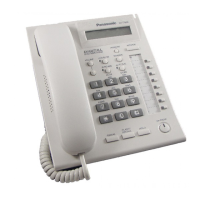
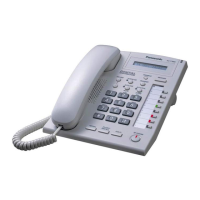
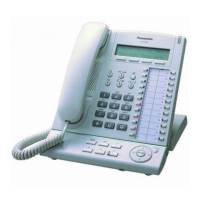
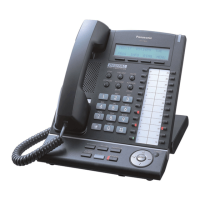
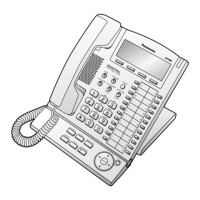
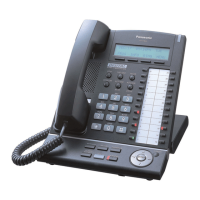

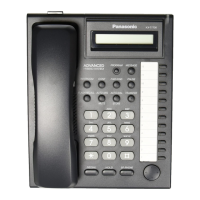
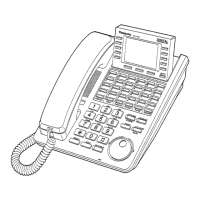

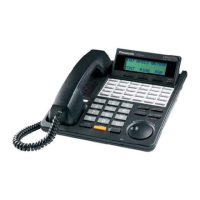
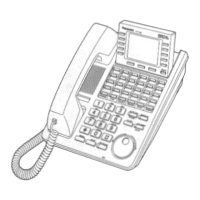
